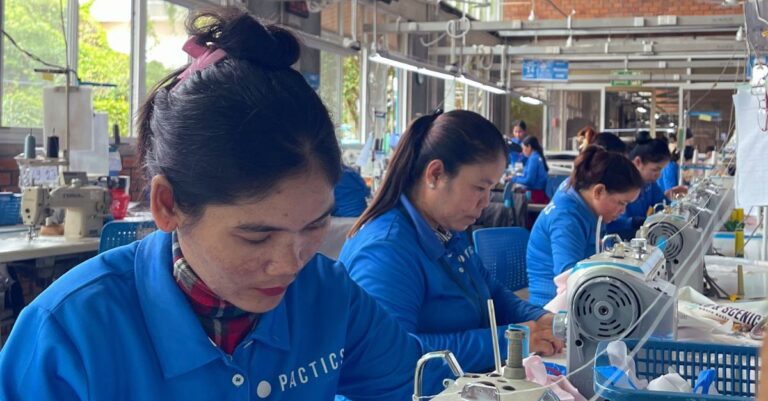The global textile and apparel industry, with a staggering retail market valuation of $1.9 trillion in 2019 (1), stands as a linchpin of the global economy. However, its pivotal role is marred by a pressing issue – textile waste. This industry generates a mind-boggling 92 million tons of waste annually (2), contributing significantly to man-made global warming, environmental degradation, and adverse health effects. As a microcosm of this challenge, Europe and North America grapple with the weighty issue of post-consumer textile waste, while Southeast Asian nations like Cambodia
confront the specter of post-industrial waste.
Amid this backdrop, my internship journey at Pactics unfolded, a company specializing in technical textiles and committed to positive impact.

Amid this backdrop, my internship journey at Pactics unfolded, a company specializing in technical textiles and committed to positive impact. Even as they prioritize eco-conscious practices, Pactics, like many in the industry, wrestles with the inevitable generation of fabric scrap waste, especially during the cutting phase. To tackle this issue, they’ve entered into a partnership with Chip Mong Group, aiming to divert waste
away from landfills through incineration for energy recovery. Yet, as we’ve come to realize, incineration, once considered an environmental remedy, is far from ideal. Moreover, the financial responsibility of waste disposal rests on the company, urging the need for an alternative solution that can effectively address both environmental and cost-related challenges.
And so, the focal point of my research inquiry revolved around this question: How can Pactics effectively repurpose fabric scraps, steering clear of
incineration and landfill disposal?
And so, the focal point of my research inquiry revolved around this question: How can Pactics effectively repurpose fabric scraps, steering clear of incineration and landfill disposal? This quest aligns with global endeavors to curb waste in the fashion industry, promising not just environmental redemption but also cost savings to manufacturers.
At its core, my work aimed to provide Pactics with a comprehensive vista of materials, viable recycling technologies, and options for repurposed products. For each of these components, my work also aimed at evaluating the technical and legal feasibility, along with identifying suitable selling channels. These assessments should ultimately lead to actionable insights for our initiatives.
The journey in this endeavor has been marked by significant challenges, each one a testament to the complexities of the mission, and even more
so, shaped by the unique landscape of the region.
The journey in this endeavor has been marked by significant challenges, each one a testament to the complexities of the mission, and even more so, shaped by the unique landscape of the region. Traditional Waste Management systems in Cambodia, firmly rooted in the concept of Energy Recovery, posed substantial hurdles on our path. For example, our attempts to collaborate with recycling facilities often redirected us back to
Chip Mong. Despite being equipped with the necessary machinery to handle our predominantly polyester textile waste (originally made from recycled PET bottles), these facilities hesitated to engage in textile waste management, even for trial testing, asserting that incineration was the only viable route. Additionally, the lack of infrastructure for textile recycling and machinery to process it to begin with, as well as the deficit of a concrete legal framework specific to textile waste management, urgently made this task even more challenging.
We found ways to streamline our processes and incorporate scrap materials into our product lineup, and so emphasizing waste reduction from the outset.

Acknowledging these challenges, although demanding, ignited our spirit of innovation. Given these limitations, we took a close look at our internal operations and thus what we can control. This introspection laid the foundation for our proposal, revealing opportunities to optimize pattern cutting and reintegrate scrap spaces into design. We found ways to streamline our processes and incorporate scrap materials into our product lineup, and so emphasizing waste reduction from the outset. Through practical enhancements like extra pockets, compartments, pouches, fabric luggage tags,
and zipper pulls to our bags, we also aim to improve product functionality and aesthetics, ultimately boosting customer satisfaction and our competitive edge.
In addition, we’ve envisioned and prepared a range of longer-term solutions, allowing us to adapt should circumstances change. These forward-thinking options include exploring the creation of more advanced recycled and repurposed products, such as utilizing our scraps in the production of insulation padding for active wear. While our current capabilities primarily focus on immediate-term solutions, our proactive approach ensures we are prepared to embrace more innovative strategies as our capabilities evolve.
Navigating Cambodia’s textile waste challenges, we’ve also learned that these issues affect many organizations. This understanding emphasizes the need for collaborative solutions.
It’s also worth noting here that addressing textile waste isn’t solely the responsibility of manufacturers; brands play a pivotal role too. They influence design choices and materials, often prioritizing cost-cutting, which manufacturers must adhere to. Thus, both parties share the responsibility for combating textile waste, necessitating a collaborative effort. Within the customer journey, our objective is now to delve into strategies for actively involving brands in shouldering the responsibility of managing their textile scrap more effectively.
This project transcends the boundaries of the company, venturing into a territory that spans industry and geography. It’s not just a project; it’s a pursuit of innovation. The vision here is to be amongst the first to kickstart the reshaping of the textile industry and set an example in the region. Pactics intends to maintain an ongoing dialogue to keep textile waste management a central industry topic, closely tracking trends in the ASEAN
region to ensure their efforts remain relevant. In summary, Pactics believes that tackling textile waste necessitates unity, and that this project is eventually dedicated to leading by example, forging a path toward a brighter, more durable textile industry through collaboration, optimization, and ongoing dialogue.
References:
(1): How the textile industry can help countries recover from COVID-19 – World. (2020, August 12). ReliefWeb. https://reliefweb.int/report/world/how-textile-industry-can-helpcountries-recover-covid-19
(2): Chen, X., Memon, H. A., Wang, Y., Marriam, I., & Tebyetekerwa, M. (2021). Circular Economy and Sustainability of the Clothing and Textile Industry. Mater Circ Econ, 3(1), 12.
https://doi.org/10.1007/s42824-021-00026-2
(3): Acclime Cambodia. (2023, August 16).
Tax Incentives For Businesses In Cambodia | Acclime Cambodia. https://cambodia.acclime.com/guides/tax-incentives/#:~:text=Qualified%20Investment%20Projects%20(QIP)%20are,duty%20exemptions%20and%20other%20benefits
Exclusively written for Pactics.com by Lobna Harboub
August 14th, 2023




